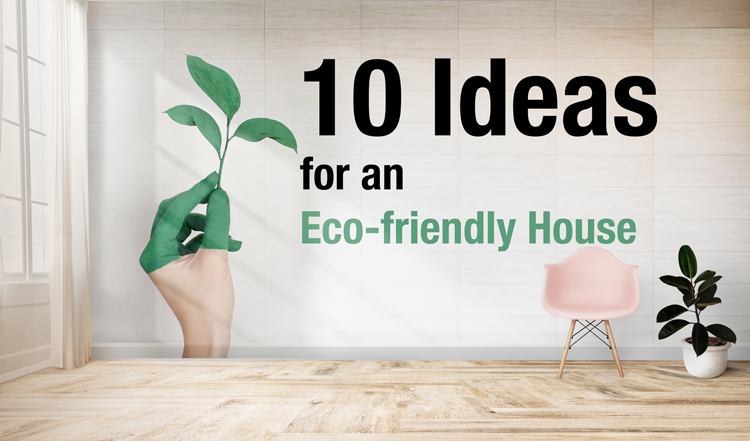Individuals including professional builders and architects are coming up with new designs and plans for constructing and marketing Eco-friendly houses and buildings. An increase in awareness about conserving natural resources and reducing carbon footprint has increased the demand for a sustainable and Eco-friendly environment. Therefore, it is equally important along with other factors to prioritize on Eco-friendly house, which can fetch you long-term energy savings and ultimately benefits you economically. So here, I discuss 10 feasible ideas that you could incorporate into your construction plans, which will definitely fetch you or your clients better power savings. Most importantly it makes you extra proud to own an Eco-friendly house.
1. Plan for the Design
Design in a manner that requires less utility of power. Large windows with cooling glasses are a good option to let the solar light into your house and at the same time resist the loss of heat. It keeps your house bright during the day time. Plan on your kitchen room design efficiently so as to reduce excessive usage of exhaust and chimneys.
2. Alternatives for wooden doors and furniture
Doors of different materials like uPVC and fiberglass are innovatively designed considering the security aspects. UPVC doors are made out of recycled material, these doors are heat-insulating and soundproof. Fiberglass doors require less maintenance and can withstand extreme weather without any corrosion or cracks unlike its metal or wooden counterparts. These doors are highly energy efficient.
Recently sustainable furniture brands have come into existence that offer affordable Eco-friendly furniture options. Recycled wooden furniture also serves the purpose of Eco-friendly furniture.
3. Planting plants
The right plant at the right space adds up more beauty to your place. You can opt for indoor plants or keep them in your balcony or plan for a small garden as per the availability of the site. Plants always keep the house environment fresh and green. It also makes your house look livelier. It is also reported that some of the indoor plants including ferns and aloe Vera plants help in purification of indoor air. Please find a few of the easily grown and beneficial plant lists here.
4. Go Solar
Utilizing solar energy is ultimately the best way to save non-renewable forms of energy. Although the initial cost of a solar panel installment is high in the long process, it saves a considerable amount of electricity and reduces power costs.
5. Rely on recycling and biodegradable materials
Follow a theme of Recycle and Reuse and go as much creative as you’d like to be. Substitute ashcrete instead of concrete, recycled glass tile for window panes, recycled steel for kitchen cabinets, newspaper wood for some light duty furniture, recycled cork panels for flooring, etc. To know more about the same click here.
6. Cool your roof
If it’s a direct terrace house then it is advised to cover your roof or ceiling with heat-insulating materials like cellulose insulation, polyurethane spray foam insulation, etc. These insulators help in keeping your house cold in summers and warm in winters. Terrace gardens are also one of the other ideas to prevent heat absorption. The plants and grass provide shade to the roof and the earth helps in insulation. Wetness in mud will certainly keep the roof cool.
7. Focus on water
Choose appropriate quality water taps to avoid leakage of water from faulty water taps. The Altered nozzle is rated as the world’s most extreme water-saving nozzle. It installs easily into your existing tap. By atomizing water we can use 98% less water and still retain full functionality.
8. Opt for dual flush toilets
To save even further on water consumption, choose a dual flush toilet. These toilets offer two flush options, one for liquid waste and the other for solid waste (usually 0.8 and 1.6 gallons respectively per flush). With these toilets, a substantial amount of toilet water consumption can be saved.
9. Using CFLs and LEDs
LEDs are the most efficient lighting option available in the market. Electricity consumption of a LED is 50% less than a CFL for the same amount of light. LEDs are long-lasting and are usually maintenance-free. The only drawback of LEDs is the angle covered by the light. CFLs provide light in all 360 deg. whereas in LED the angle depends on the kind of reflector used in the bulb. Some LEDs provide larger angles so that is something that should be checked before buying. Usually CFLs work better for open or large space area like living room whereas LEDs are a better option for closed or small rooms.
10. Rain water harvesting systems
As climate change is daunting us for our near future, there can be a significant possibility of the scarcity of rain. Therefore it is always wise to have safer plans for the future and utilize the available sources efficiently. Rainwater harvesting saves the rainwater for your use during times of water scarcity.
An instance of Eco-friendly house
Srihari Alamsetti, a resident of Bangalore, wished to own a house that was more earthy and Eco-friendly. Almost two years after consulting an architect, the family shifted to their new house. This new house had beautiful interiors and looked just like any other building, built of concrete and bricks, but it was not. The building material used is stabilized mud blocks. The rainwater harvesting system in the house collects water for drinking and cooking. It treats wastewater in the garden. The bungalow has a large basement that gets daylight and is visually connected with the rest of the house.
“The overall cost of construction including fittings is Rs. 1350 per square foot. This is the same as what we would spend to build a traditional house,” says Alamsetti.
If you believe more in conserving the environment and sustainable development, then you may also enjoy ‘sustainable health care’. An article which briefs about the importance of achieving sustainability in the healthcare sector.
